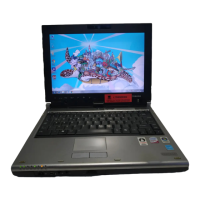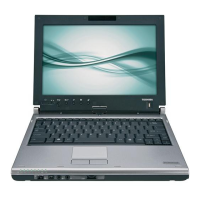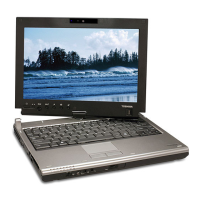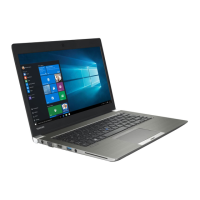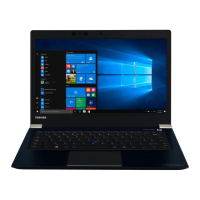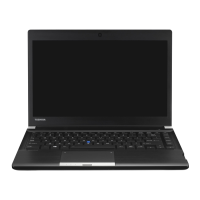
Do you have a question about the Toshiba PORTEGE M900 and is the answer not in the manual?
| Graphics | Intel GMA 4500MHD |
|---|---|
| Optical Drive | DVD SuperMulti Drive |
| Wireless | Wi-Fi 802.11a/g/n, Bluetooth 2.1+EDR |
| Processor | Intel Core 2 Duo |
| Storage | Up to 320GB HDD |
| Display Resolution | 1280x800 |
| Operating System | Windows Vista / Windows 7 |
| Battery Life | Up to 4 hours |
| Ports | 3x USB 2.0, VGA, Ethernet |
| Weight | 1.9 kg (4.19 lbs) with battery |
Lists all items included in the computer package for verification.
Overview of processor, memory, display, ports, and other hardware components.
Details on security measures, hot keys, and unique computer functionalities.
Description of pre-installed software like Power Saver and Fingerprint Utility.
Information on adding memory, battery packs, and AC adaptors for expanded capabilities.
Identifies key components on the front, sides, and underside of the computer.
Details on the optical drive, region codes, and the computer's AC power adaptor.
Guides for connecting power, opening the display, and turning the computer on.
Explains Sleep, Hibernation, and system auto-off features for power saving.
Steps for restarting, system recovery, and creating recovery media.
How to use the TouchPad, fingerprint sensor, webcam, microphone, and Face Recognition.
Instructions for loading, removing, and using optical disc drives and media.
Managing audio settings, modem, LAN, and wireless communication.
Guidelines for cleaning, moving, HDD protection, and touchscreen usage.
Overview of typewriter keys, function keys, and special keyboard layouts.
Details on F1-F12 keys, Fn key combinations, and hot keys for system control.
How to activate the numeric keypad overlay and generate ASCII characters.
Explains the function of Windows logo and application keys.
Explains power indicators, battery types, charging, and monitoring.
Tips for maximizing battery life and procedures for replacing the battery pack.
Setting passwords, using power-up modes (Boot, Sleep, Hibernation).
How to launch and use the HW Setup utility for configuring hardware settings.
Settings for display, boot priority, keyboard, USB, LAN, and illumination.
Information on using memory cards and installing additional RAM modules.
How to use ExpressCards and connect external monitors via HDMI.
Details on extra battery packs, AC adaptors, and security lock usage.
General guidelines for diagnosing and resolving computer problems effectively.
Solutions for startup, power, overheating, and battery issues.
Guides for resolving issues with LCD, drives, input devices, and network connections.
Troubleshooting for recovery discs, optical drives, USB devices, and memory card errors.
Technical specifications for operating environment and power supply.
Detailed specs for the built-in modem, including protocols and speeds.
Explains how the display controller manages graphics and video output for internal/external displays.
Technical details of the wireless LAN card, including standards and data rates.
Information on radio frequencies, modulation, and factors affecting wireless range.
Details on power cord requirements, length, wire size, and agency certifications.
How to start and use the PC Health Monitor for system diagnostics and usage tracking.
Legal notes on CPU performance, memory usage, and battery life variations.
Legal information on HDD capacity calculation and LCD screen limitations.
A list of common abbreviations used in the manual with their full forms.
Definitions of various technical terms related to computer hardware and software.
An alphabetical guide to manual topics with page numbers for easy navigation.



